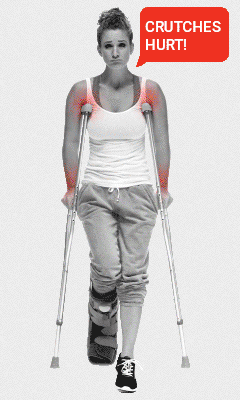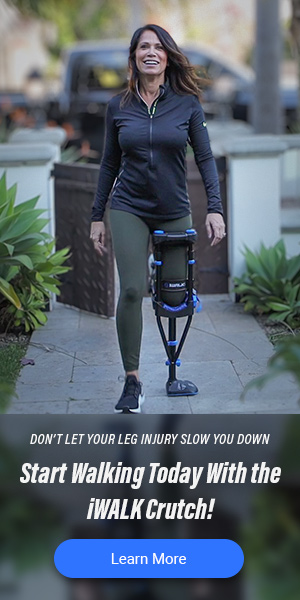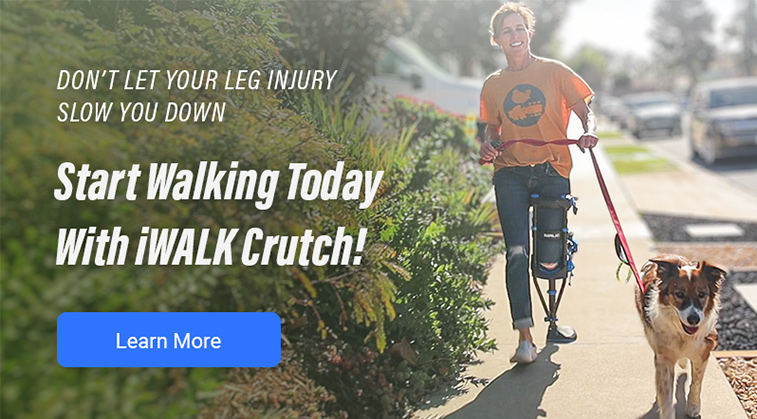Lower Leg Injury Resource Center
Fibula Fracture
Symptoms, Causes, Treatments, Surgery and Recovery
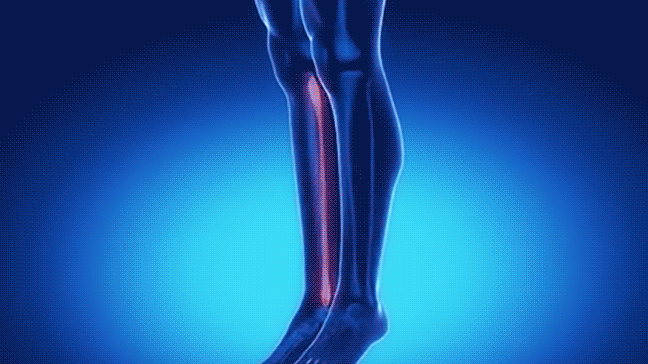
Fibula fractures are a common injury to the smaller of the two lower leg bones. Fractures of the fibula can occur in conjunction with a tibia fracture or a broken ankle. While many broken fibulas occur because of a strong impact, stress fractures are also common, especially among athletes. Recovery usually takes six or more weeks, may require surgery and often requires a period of non-weight bearing activity.
I
WHAT IS THE FIBULA?
The fibula is one of the four longest bones in the body [1] and the smaller of the two leg bones extending between the knee and ankle. It’s sometimes called the calf bone and sits slightly behind and to the outside of the tibia. The fibula is vulnerable to breaks because of its size.

What Does the Fibula Do?
The fibula primary functions as a point of attachment for many muscles in the lower leg, and as a support to the larger tibia [2]. Because of this big job, and the inherent forces placed on the bone by so many muscles, fibula stress fractures are common. The fibula only supports between 14 and 17 percent of the body’s weight, while the larger tibia supports the majority.
While fibula fractures don’t get the same high-profile attention as tibia or femur fractures, they occasionally make front page news. A prominent example occurred during a Christmas Eve NFL football game when Oakland Raiders (now Las Vegas Raiders) quarterback Derek Carr suffered a devastating broken fibula. The injury required surgery and ended his hunt for both MVP and a Superbowl appearance, but didn’t end his career. In fact, he recovered and was voted to the Pro Bowl the following season.
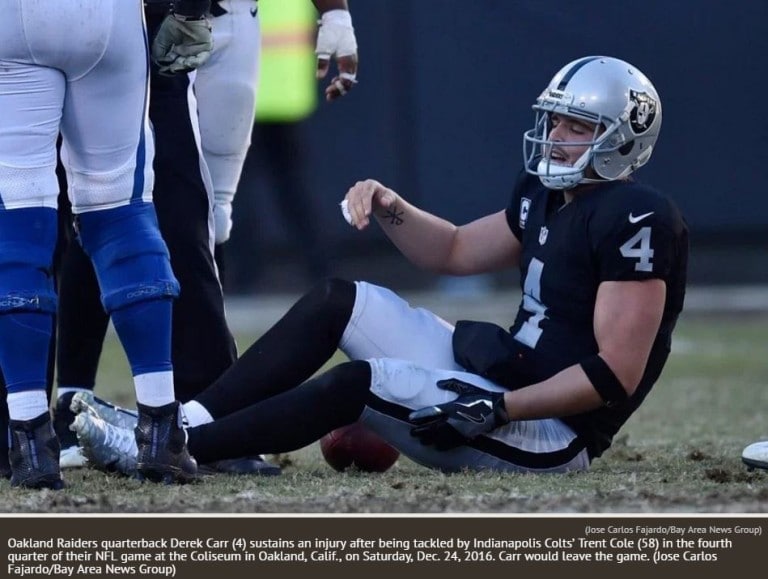
I
CAUSES AND TYPES OF FIBULAR FRACTURES
Fibula fractures can either be complete, when the break goes through the whole bone, or incomplete, when the break goes only part-way through the bone. The fracture may occur anywhere along the bone between the knee and ankle. Displaced fractures—when the bone becomes misaligned—are very rare in fibula fractures.

The most common fibula fractures are:
Lateral malleolus fracture: The most common type of ankle break, the lateral malleolus fracture occurs when the ankle is twisted or awkwardly rolled. The lateral malleolus is the name given to the outside of the ankle joint, which is at the lower end of the fibula. Recovery usually takes at least six weeks.
Bimalleolar ankle fracture: The bimalleolar ankle fracture occurs in both the inside and outside malleoli at the lower end of the fibula and tibia bones of the lower leg. In other words, it’s when both sides of the ankle are broken at the same time. Surgery is typically the best course of action, and recovery takes at least six weeks.
Tibia fibula fractures: A tibia fibula fracture is when both of the long bones in the lower leg are broken. Also known as a tib fib fracture, the injury is usually caused by severe trauma resulting from car crashes, sports injuries or falls. Recovery can take three to six months.
Fibula stress fracture: A fibula stress fracture is common among athletes and results from repeated stress to the fibula bone of the lower leg. Stress fractures can affect long-distance runners and usually worsen with increasing activity. Recovery can take six weeks or more.
I
BROKEN FIBULA SYMPTOMS
Symptoms of a broken fibula range from difficulty standing to a compound fracture that protrudes through the skin. Delayed treatment of a broken bone can result in a worsening injury that inflicts damage to the surrounding ligaments and tissue [3]. If you experience any of the following symptoms, see a medical professional immediately.
- You may have difficulty walking or bearing weight on the injured leg.
- There may be swelling or bruising on you lower leg at the site of the injury.
- With severe fractures, there may be a bone protruding through the skin or an obvious deformity.

I
DIAGNOSIS OF A FIBULA FRACTURE
When you see your doctor about a possible fibula fracture, they will likely order tests to determine the extent of the injury and help inform treatments.
X-rays are a frequently-used imaging technique that will reveal if the fibula is broken or displaced, how many individual fractures occurred, and whether or not other bones were involved in the injury [4].
Computed tomography scans, commonly called CT scans, are a painless test that creates a cross-section image of your limb. A CT scan can provide valuable information about the severity of an injury and help determine if the ankle or knee joints were involved.

I
TREATMENT OF A BROKEN FIBULA
The treatment of a fractured fibula depends on the injury’s severity and whether additional injuries have also occurred. Isolated fibula fractures usually heal quickly and do not require surgery, especially if the break occurs in the upper half of the bone.
Non-Surgical Methods Treatments for a Fibula Fracture
RICE is an acronym that stands for Rest, Ice, Compression and Elevation. It’s a method of reducing pain and inflammation and requires that the injured person stop putting weight on the affected extremity, ice it, wrap it and keep it elevated.
This simple regiment can help to completely heal some minor fibula stress fractures. Your doctor may recommend that you walk with crutches, use a knee scooter, or other crutch alternative such as iWALK hands-free crutch, which facilitates mobility while adhering to orders not to weight the affected leg.
Splint: Your doctor may suggest putting a splint on the lower leg to provide comfort and support. A splint can be tightened or loosened, which is helpful when you need to accommodate swelling. Once swelling subsides, your doctor may consider additional treatments.
Brace or walking boot: Your doctor may recommend both a brace and walking boot to restrain the injured leg and allow it to heal.
Non-weight bearing regimen: As with many foot, ankle and lower leg injuries, doctors often recommend a period of non-weight bearing activity during which no weight can be put on the injured leg or foot.
There are some rare instances when patients with a broken fibula will be able to stand right away, but most doctors will ask their patients to wait six weeks before bearing weight.
If symptoms worsen or do not improve after a couple of weeks, surgery may be an appropriate course of action. Surgery may also be required if the injury is more complex and involves the tibia, ankle, or other muscles and ligaments.

Surgical Methods to Repair a Broken Fibula
Fibula fractures don’t usually require surgery, but there are circumstances when it may be recommended [5]:
- When the tibia and fibula are both fractured,
- The fracture is near the ankle, or
- Other muscles, ligaments and soft tissue are injured.
If you choose fibula surgery, your doctor will use plates, screws or wires to fasten the fractured bone in place. They will return bone fragments to their normal alignment and secure them using screws and metal plates that attach to the bone’s outer surface. There may be injuries that require a screw or nail to be inserted into the middle of the bone to hold it in place.
I
BROKEN FIBULA RECOVERY TIME
Patients with fractured fibulas tend to make full recoveries when they follow their doctor’s instructions. The severity of the injury will dictate how long a full recovery will take.
With minor fractures, most patients return to the majority of their activities, including sports, in as few as six weeks. Severe fibula fractures that include associated injuries to other bones, nerves, blood vessels and connective tissue will require a significantly longer recovery time.
How Long Does a Broken Fibula Take To Heal?
Recovery from a broken fibula depends on the severity of your injury and generally takes between six and eight weeks.
The recovery period generally includes resting, icing and elevating your injured leg. It also often requires a period of non-weight bearing activity when you can’t stand or walk on the affected leg—usually for at least six weeks. The length of time you’ll be non-weight bearing will depend on how quickly you gain stability in the injured leg and ankle [7].
If surgery is required, you’ll most likely wear a splint. When swelling has subsided, a cast or boot may be used to support the healing bone or bones.
Physical therapy may be prescribed while you wear a splint, cast or boot. This will help strengthen the surrounding muscles, prevent atrophy, and restore normal joint movement and flexibility. Your doctor or physical therapist may also encourage some leg motion in the very early recovery period to avoid stiffness.
I
CAN YOU WALK ON A FRACTURED FIBULA?
A broken fibula will generally heal with few complications if you follow your doctor’s instructions. That will probably mean keeping weight off the injured leg for a few weeks to a few months, depending on your injury’s severity [8].
A doctor may suggest putting some weight on the injured leg right away, but a more serious or complicated fracture could require that you keep weight off your injured leg for weeks or months. Following your doctor’s instructions carefully will speed recovery and prevent further injury.
A prescription to keep weight completely off your injured leg can be challenging to follow, but adhering to timeline will speed recovery and prevent further injury [9]. Moreover, compliance may depend in part on the type of walking aid you choose. Your choices include traditional crutches, or, provided the injury is in the lower part of your fibula, a knee scooter or knee walker, or a hands-free alternative like the iWALK hands-free crutch.
I
MOBILITY DEVICE OPTIONS FOR FIBULA FRACTURE RECOVERY
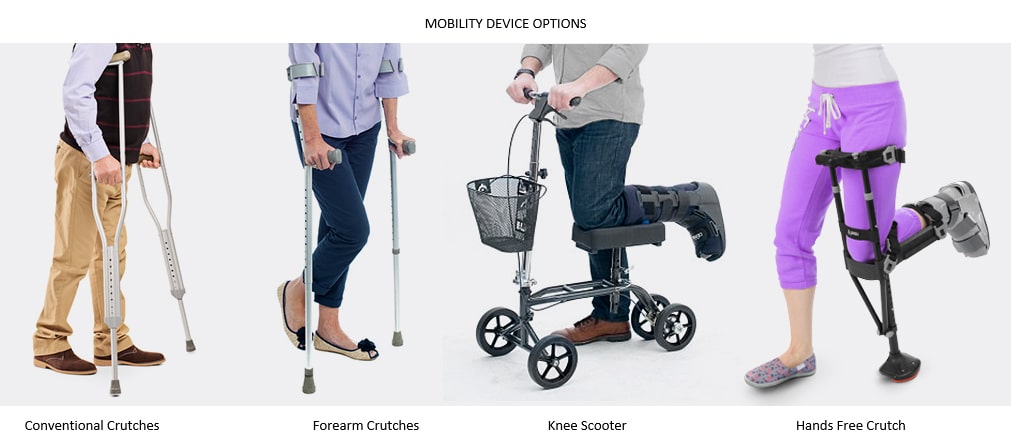
Traditional Crutches
Traditional crutches are used by millions worldwide. Designs vary between underarm and elbow crutches, and both styles are relatively cheap and easy to obtain.
Traditional Crutches can also be frustrating, however, because they require use of your hands and arms, which makes carrying anything or doing most day-to-day chores nearly impossible. Traditional crutches are also exhausting and can cause pain in your hands, arms and shoulders. This generally makes them practical for short distances. It’s not surprising that increasing numbers of people are choosing to use alternative mobility devices.
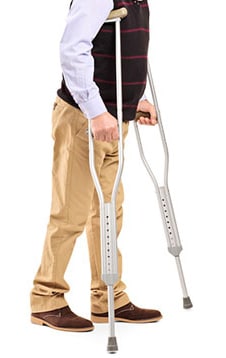
Knee Scooters or Knee Walkers
A knee scooter, also known as a knee walker, provides a platform for your injured leg and has wheels and a handlebar. Knee scooters require less upper body strength than crutches but aren’t ideal for movement on stairs, slopes, in small areas or uneven terrain. Moreover, they require use of your hands, which makes daily tasks like feeding the dog or carrying a bag of groceries challenging.
Because knee scooters require you to rest your lower leg on a padded platform, they may not be compatible for use with fibula fractures that occur in the upper part of the lower leg.
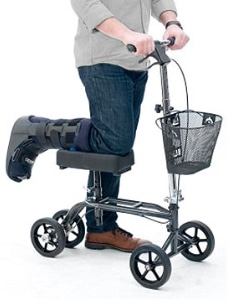
iWALK Hands-Free Crutch
The iWALK hands-free crutch makes it possible for a person to keep weight off their injured leg while keeping their arms and hands free. It resembles a high-tech pirate leg with a padded platform for you injured leg. Strapped on properly, the iWALK hands-free crutch becomes an extension of your leg and allows you hands-free mobility so you can continue a functional lifestyle during the non-weight bearing period of your recovery.
Moreover, studies show the iWALK simulates normal walking in a way that engages upper and lower leg muscles while immobilizing the foot. This boosts blood flow in the lower leg and foot, which speeds recovery time. Engaging lower leg muscles while using the iWalk also avoids muscle atrophy that’s unavoidable using traditional crutches or knee scooters.
As with knee scooters, the iWALK require you to rest your lower leg on a padded platform and may not be compatible for use with fibula fractures that occur in the upper part of the lower leg. The majority of fibula fractures occur in the ankle area, however, and are compatible with the iWALK. To learn more about the iWALK crutch, click here.
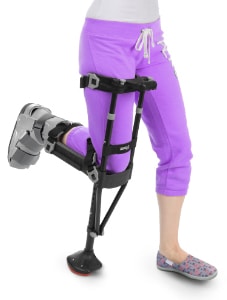
I
FIBULA FRACTURE SUMMARY
As with most injuries, fibula fractures depend on the how the injury occurred and range from moderate to severe. Full recovery takes plenty of patience and rest and depends on the patient’s willingness to follow their doctor’s recovery roadmap. Without these, the risk for re-injury increases. Fortunately, most people who suffer a fractured fibula heal completely and return to normal levels of activity, including participation in athletics.
The information above is intended for informational purposes only and is not intended to prevent, treat, or diagnose any illness or disease. We aim to provide the highest quality information, so if you have any questions on the information above, we welcome your feedback!
I
RESOURCES
- Valencia Higuera and William Morrison, M.D. What to know about fibula fractures. Medical News Today. 2 February 2017. https://www.medicalnewstoday.com/articles/315565.php
- Fractured Fibula. Hartford HealthCare, Hartford Hospital. Accessed 2 September 2021. https://hartfordhospital.org/services/bone-joint-institute/conditions/sports-injuries/fractured-fibula
- Mayo Clinic Staff. Broken leg. Mayo Clinic. Accessed 2 September 2021. https://www.mayoclinic.org/diseases-conditions/broken-leg/symptoms-causes/syc-20370412
- Tibia and Fibula Fractures. Johns Hopkins Medicine. Accessed 2 September 2021. https://www.hopkinsmedicine.org/health/conditions-and-diseases/tibia-and-fibula-fractures
- Tibia/Fibula Fracture Open Reduction and Internal Fixation. Johns Hopkins Medicine. Accessed 2 September 2021. https://www.hopkinsmedicine.org/health/treatment-tests-and-therapies/tibiafibula-fracture-open-reduction-and-internal-fixation
- Telling Pain to Take a Hike: Rehabilitation After a Broken Fibula. Ability Rehabilitation. Accessed 2 September 2021. https://abilityrehabilitation.com/physical-therapy/rehab-broken-fibula/
- Give Your Broken or Fractured Fibula the Boot for Fast Recovery. Saint Alphonsus Rehabilitation Services. Accessed 2 September 2021. https://www.starspt.org/give-broken-fibula-boot/
- Mary D. Daley, MD, MSc. How to Tell Between a Sprained Ankle and a Broken Ankle. Healthfully. 11 December 2018. https://www.livestrong.com/article/162263-symptoms-of-a-broken-fibula/
- Jesse Shaw, M.D. Broken Fibula Needs Time and Patience. All-Pro Orthopedics and Sports Medicine. 23 November 2020. https://allproorthopedics.com/blog/broken-fibula-needs-time-and-patience/

